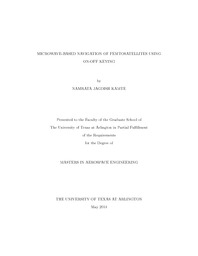
ATTENTION: The works hosted here are being migrated to a new repository that will consolidate resources, improve discoverability, and better show UTA's research impact on the global community. We will update authors as the migration progresses. Please see MavMatrix for more information.
Show simple item record
| dc.contributor.author | Kamte, Namrata J. | en_US |
| dc.date.accessioned | 2014-07-14T20:28:38Z | |
| dc.date.available | 2014-07-14T20:28:38Z | |
| dc.date.issued | 2014-07-14 | |
| dc.date.submitted | January 2014 | en_US |
| dc.identifier.other | DISS-12628 | en_US |
| dc.identifier.uri | http://hdl.handle.net/10106/24462 | |
| dc.description.abstract | The objective of this research is to validate that a custom-built microchip-scale satellite transmitting a signal modulated with a Pseudo Random Noise code using On-Off Keying, can be tracked. The weak GPS satellite signal is modulated with a Pseudo Random Noise (PRN) code that provides a mathematical gain. Our signal is modulated with the same PRN code using On-Off Keying (OOK) unlike Phase Shift Keying used in GPS satellites. Our goal is to obtain timing and positioning information from the microchip-scale satellite via a ground station using the concepts of PRN encoding and the OOK modulation technique.Decimeter scale satellites, with a mass of 2-6 kilograms, referred to as picosatellites, have been tracked successfully by ground stations. The microchip-scale satellite, called the femtosatellite is smaller with even less mass, at most 100 grams. At this size the satellite can take advantage of small-scale physics to perform maneuver, such as solar pressure, which only slightly perturb large spacecraft. Additionally, the reduced size decreases the cost of launch as compared to the picosatellites. A swarm of such femtostellites can serve as environmental probes, interplanetary chemists or in-orbit inspectors of the parent spacecraft. In May 2011, NASA's last space shuttle mission STS-134 carried femtosatellites developed by Cornell researchers called ``Sprites''. The sprites were deployed from the International Space Station but ground stations on Earth failed to track them. In an effort to develop an alternative femtosatellite design, we have built our own femtosatellite prototype.Our femtosatellite prototype contains the AVR microcontroller on an Arduino board. This assembly is connected to a radio transmitter and a custom antenna transmitting a 433 Mhz radio frequency signal. The prototype transmits a PRN code modulated onto the signal using OOK. Our ground station consists of a Universal Software Radio Peripheral (USRP) with a custom antenna for reception of the 433 MHz signal. The USRP is driven by an open source software-defined radio application called GNU Radio. The required components of the signal are extracted from GNU Radio and processed in order to plot the received data.Benchtop testing of these OOK signals has yielded a reception sensitivity of upto 1 microsecond, which translates into a ranging capability similar to that of GPS satellites. We have correlated the received and replica PRN sequences and demonstrated that they match. The correlation can be used to obtain the identity and position of the femtosatellite prototype. This demonstrates the ability to track a femtosatellite signal that is lower than ambient noise, just like the signals broadcast from GPS satellites. Further, we have performed a system analysis and recognized key system behavioral problems. Thus we have determinately developed an optimum femtosatellite prototype and designed a novel positioning signal, providing a stepping-stone in the journey of successful femtosatellite communication. | en_US |
| dc.description.sponsorship | Harris, Ben | en_US |
| dc.language.iso | en | en_US |
| dc.publisher | Aerospace Engineering | en_US |
| dc.title | Microwave-based Navigation Of Femtosatellites Using On-off Keying | en_US |
| dc.type | M.S. | en_US |
| dc.contributor.committeeChair | Harris, Ben | en_US |
| dc.degree.department | Aerospace Engineering | en_US |
| dc.degree.discipline | Aerospace Engineering | en_US |
| dc.degree.grantor | University of Texas at Arlington | en_US |
| dc.degree.level | masters | en_US |
| dc.degree.name | M.S. | en_US |
Files in this item
- Name:
- Kamte_uta_2502M_12628.pdf
- Size:
- 10.72Mb
- Format:
- PDF
This item appears in the following Collection(s)
Show simple item record


